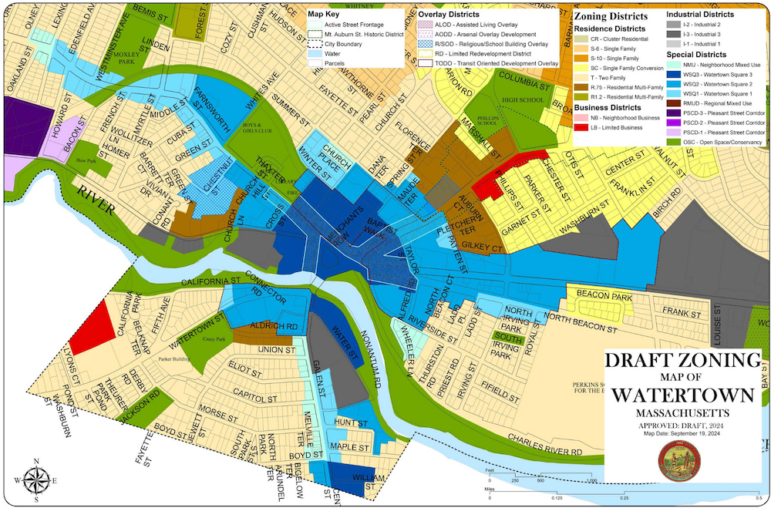
(Updated Oct. 29: ADUs are limited to single family properties in districts that allow them by right.)
When the zoning changes proposed to make the Watertown Square Area Plan a reality were presented last week, the City Council and Planning Board didn’t get to dig down on a few areas, including accessory dwelling units (i.e. in-law units), what constitutes a household for residential units, and the new Neighborhood Mixed Use zones.
City Council President Mark Sideris said he would like to have more discussions about those areas when the public hearing on the Watertown Square zoning continues on Thursday, Oct. 24 at 6 p.m. in City Hall.
Another area that Sideris wanted to have discussion about is what happens when a property falls in two different zones including one of the new Watertown Square zones. He asked whether the property owner could choose which zoning to use, or whether it defaults to the new zone or the old one.
ADUs
ADUs (the acronym for Accessory Dwelling Units) were an addition to the zoning proposal for Watertown Square and beyond. Like the addition of by-right housing in the Watertown Square Area Plan, the ADU zoning also was added to meet a new requirement that came from state legislation. Communities must allow the in-law units by-right and must make the changes by February, said Assistant City Manager Steve Magoon.
The accessory units will impact areas outside the Watertown Square area. They will be allowed in zones where a single family home is allowed by-right, Magoon said, and are limited to single family properties.
The ADUs can be in the basement, attached to homes, or unattached — such as a garage. The proposed zoning meets the minimum standard required by the state, and City Manager George Proakis said the Council and Planning Board could decide at a later date to allow the ADUs in more circumstances.
Households
An issue brought up by multiple residents was how many people are allowed in home, and how there is a difference for a family vs. unrelated people. The current City zoning allows for up to 10 related people, while no more than four unrelated people can live in a home.
Some people who spoke said that the definition of a family sounded outdated to them, and does not include many family units that exist in Watertown today. They noted that the limit of four unrelated people applies regardless of the number of bedrooms. Some suggested using the state’s Sanitary Code as the guide to the number of people who can be in a home. That code requires each bedroom to have at least 70 sq. ft. of floor space, and at least 50 sq. ft. of floor space for each person in a bedroom.
Magoon said that the limit of unrelated people can be one of the ways to enforce certain regulations.
“It’s difficult when a property owner is absentee and people are in and out all times of day and cars are parked all over the property,” Magoon said. “I need something to go to the proper owner with.”
Neighborhood Mixed Use
The Watertown Square Zoning adds three zones allowing for multi-use residential buildings to the City’s Zoning Ordinance with 3+ stories (three full stories with the top floor pushed back 7 feet from the facade or with a pitched roof) in WSQ1, 4+ stories in WSQ2, and 5+ in WSQ3 . In July, the City also added a fourth new zone, the Neighborhood Mixed Use zone, which allow for three story buildings with commercial on the ground floor and two floors of residential above it.
The largest proposed NMU zone is on the westside of Galen Street. Other areas are on Main Street, between Lexington and Olney streets, the area between Riverside Street and Wheeler Lane near the intersection with North Beacon Street, and the south side of Summer Street between Church and Pearl streets.
The area along Galen Street was made Neighborhood Mixed Use, because the neighborhoods behind off Galen are mostly single and two-family homes. It is meant to be a transition or buffer between the 3+ stories allowed on the other side of Galen. The buildings on Galen Street with commercial on the ground floor were built before the Zoning was first introduced, and would not be allowed in current zoning, said Director of Planning and Zoning Gideon Schreiber.
Advocates for more dense housing said that area of Galen Street should have larger residential buildings because it is near Watertown Yard, one of the City’s transportation hubs.
Members of the Planning Board also asked why only part of Summer Street is NMU, and blocks on the same side allow for 3+ or 4+ story residential buildings.
The City Council and Planning Board will continue the discussion of the Watertown Square Area Plan Zoning on Thursday, Oct. 24 at 6 p.m. The meeting will be in City Hall in the Council Chambers. See more information here.
See the details of the proposed zoning changes by clicking here.